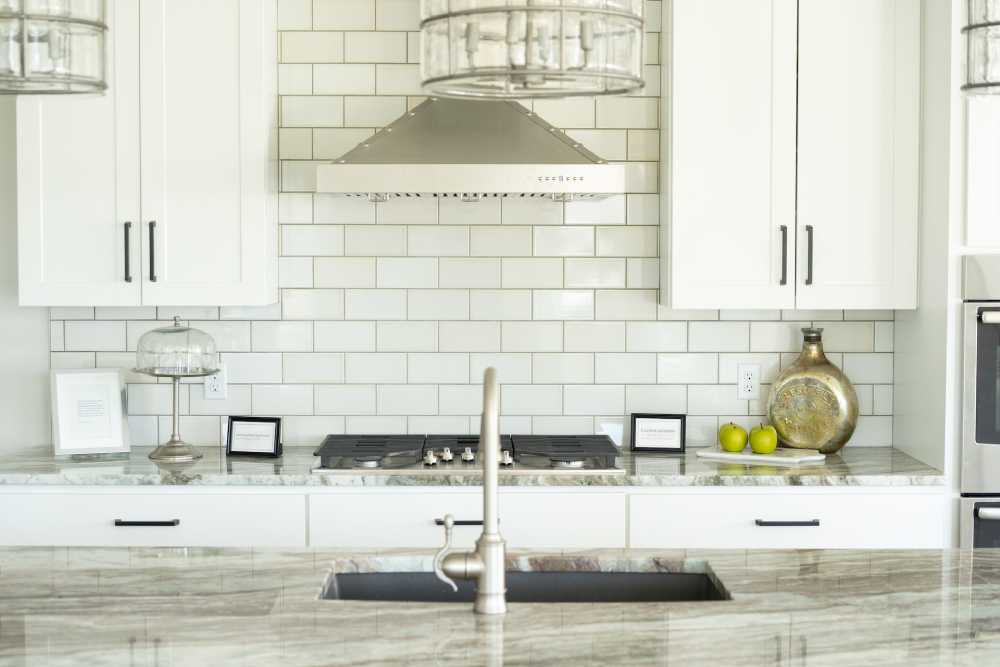Subway tile is a classic material that works well in many spaces. It’s the most traditional style and the best option for homeowners who want a timeless look that will withstand frequent cleaning and scrubbing. However, it can still be modernized with a herringbone pattern or other tweaks!
Running Bond
Running Bond is a classic tile pattern with a symmetrical layout that presents a crisp, clean stage for any space. It is an excellent choice for a subway tile backsplash, especially for beginners, as it requires fewer complicated tile cuts than other patterns.
This horizontal brick-setting tile pattern is likely what you imagine when you think of subway tiles, and it’s a great option to hide imperfections like uneven surfaces or crooked walls. The pattern’s staggered design tricks the eye by taking attention away from individual pieces and presenting a coherent whole that is easy to sweep the eye across.
Another benefit to this running bond layout is that it makes your grout lines appear more uniform and less stark. This is because each tile’s short ends align with the tile’s centerline above and below – also known as a 50-percent offset. If you’re wondering about the way to grout subway tile to achieve the best results, it’s important to consider factors like grout color and spacing for a polished finish. While a running bond layout is the most popular way to install subway tile, other options can make a statement.
For example, herringbone tile creates an eye-catching zigzag look that’s at once modern and vintage. This unique style pairs perfectly with a boldly colored tile or an earthy, natural-looking grout color. You can also use a herringbone pattern with smaller tile planks, such as porcelain or glass, for an eye-catching focal point in your kitchen backsplash.
Basket Weave
Subway tile is a timeless material that meshes well with various decorating styles. It’s also versatile and can take on a variety of patterns and layouts. While the traditional running bond and herringbone patterns remain classics, you can create an intriguing tile installation in several other ways. One example is the basket weave tile pattern, which showcases uniform squares to add texture and dimension to walls.
This popular kitchen backsplash option is ideal for large-format subway tiles. It helps to avoid the lippage effect that can occur with larger tiles. To create a basket weave pattern, begin with a standard running bond installation and then shift the layout to alternate the direction of the tiles.
Another way to give a simple subway tile treatment a designer look is with a vertically stacked bond tile pattern. This arrangement features same-size subway tiles that are aligned in tidy rows. It’s an easy-to-lay-out, minimalist design that presents a clean stage for busy kitchens. A herringbone tile pattern is a modern classic that’s great for creating a bold statement.
It is best paired with a contrasting grout color to pop the v-shaped rows. For example, a herringbone tile backsplash looks aggressive with gray grout, while white subway tiles and crisp white grout create a light and airy kitchen.
English Bond
If you are looking for a classic subway tile pattern that is as versatile as it is timeless, consider the English bond. This layout uses a herringbone-like arrangement but without the stair-stepped look. It’s a great choice for kitchen backsplashes or bathrooms where you can create a pattern that is both classic and interesting at the same time.
You alternate whole and half tiles to achieve the English bond tile pattern. This gives the appearance of a running bond but with more texture and movement. This pattern can make an otherwise simple space feel much more luxurious and substantial when used in large wall areas, like a backsplash or shower.
Like herringbone, the English bond works well in various kitchens and bathrooms. Pair it with a contrasting grout color to pop the tiles and bring out their unique textures. For example, a dark tile like our Mallorca White 2.5×8 subway would look striking when installed with gray grout.
Try using it in a vertical stack pattern for a modern twist on the traditional herringbone layout. This can add a touch of drama and intrigue to a room, especially when you use a light grout color. You could even try this pattern with colored subway tiles to create a bold accent wall that would contrast with the rest of your kitchen.
Classic Brick
The staggered brick or herringbone pattern is the classic subway tile layout pattern. This historically accurate style creates a very solid field of extremely durable tiles. It can be run vertically or horizontally, depending on your room.
It works great with square tiles or the more traditional rectangular ones. The beauty of the herringbone pattern is that it can be adapted to fit your space and style. It works well with all tile shapes and is a good choice for small areas where you want to ensure your grout lines line up perfectly. It’s also one of the easier layout patterns to install if your walls are not level – remember to keep track of the middle and use the center marks as your starting point.
While we love the classic look of traditional subway tiles, feel free to push the boundaries and find unique new ways to showcase them. Some of the best ideas come from altering the pattern or using different grout colors. Contrasting grout shows off the design and helps your tiles shine. Darker grout colors are best, but white will work if you prefer.





